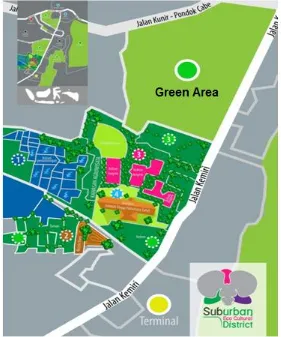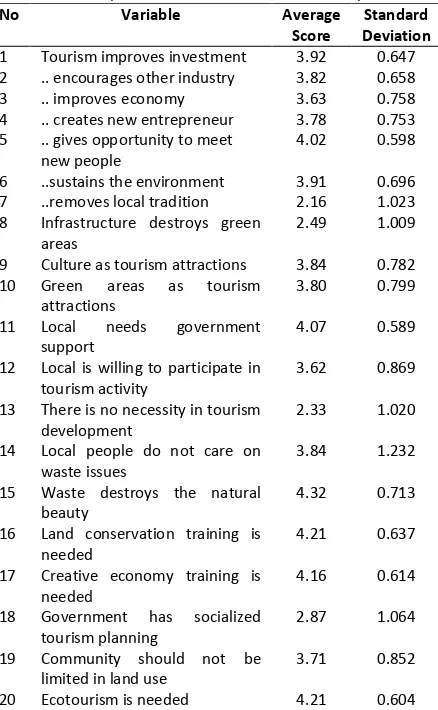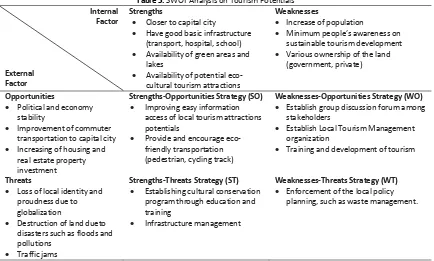J.Ind. Tour. Dev. Std., Vol.3, No.3, September, 2015
E-ISSN : 2338-1647
http://jitode.ub.ac.id
Journal of Indonesian Tourism and Development Studies
[117]
Moving Towards Eco Cultural Tourism Village
(A Case Study of Pondok Cabe Village)
Rina Kurniawati
*,
Sahid Institute of Tourism, Jakarta, Indonesia
Abstract
This study identifies some eco-cultural tourism attraction potentials that exist in Pondok Cabe Udik Village Tangerang Selatan Indonesia. In addition, it investigates local people’s opinion on tourism development. The objective is to provide a preliminary overview of eco-tourism development. This study is a descriptive study that uses three types of instrument in data collection method, including questionnaire, interview and field observation. The data is then analyzed using SWOT analysis. The result indicated that natural potential include farming, lake and fish pond, and chicken hatchery. Cultural potentials include cultural diversity that depicted in praying houses and culinary. 194 respondents involved are the locals. The result showed thatthere is positive view from the local community on the availability of tourism potentials and development in the future. It is proposed that environmental awareness, education, ecotourism development, and consensus buildingare needed to implement eco cultural tourism concept.
Keywords: Tourism, Eco-Cultural, Village, Planning and Development
INTRODUCTION
Indonesia tourism industry has an important role in Indonesia economy. It has placed itself on the 4th rank in industry contribution to national GDP after oil and gas. During the last 10 years there is positive growth in terms of international tourism [1]. The sector has contributed US$ 10 billion to national economy in the end of 2013. Tourist arrival is also predicted to grow in the future as economy continues to rise. The government of Indonesia is targeting 20 million of visitors by 2020. Although tourism industry is
growing, however tourism development
distribution is imbalance among provinces. Indonesia tourism mainly concentrates in Java and Bali, in which the infrastructure and the economy activities are there [2].
As a developing country, Indonesia is still moving forward from villages to modernization. Development in the infrastructures occur; such as transportation, roads, railways, airport, and public facilities. As development is on progress, there are some challengesfaced which include of deforestation, pollution, floods and increasing population.
One suggested alternative to achieve sustainability especially in tourism is by implementing the local wisdom [3]. Local wisdom is said to have been the concept that is able to up bring the local values for welfare and spiritual
Correspondence address:
Rina Kurniawati
Email : rinakurniawati@stpsahid.ac.id Address : Sahid Institute of Tourism, Jakarta
balance; a balance between People – God – Nature. This concept has been applied in Bali that is known as Hita Karana. The concept applied in managing its island. Local wisdom is a positive form for creative tourism that can be significant for tourism promotion [4]. Similarly the concept of sustainable tourism encourages the balance between social, economy and the environment. As tourism not only bring positive, but negative impacts on the world such as the destruction of the environment and probably to social lives. The word sustainable is the master key for a better future.
Another concept that supports sustainable development in the area of tourism is the concept of eco-cultural tourism. Russell [5] applies the concept of eco-cultural tourism as means for the sustainable development of culturally marginal and environmentally sensitive region. Other studies also had a similar view that sustainable development is achieved through eco cultural Tourism [6,7].
J.Ind. Tour. Dev. Std., Vol.3, No.3, September, 2015 [118]
Eco Cultural Tourism Village of Pondok Cabe (Kurniawati)
from an ordinary sub urban city to ASEAN award winner in environment sustainable city.
In other smaller area in South Tangerang City lays a small village – Pondok Cabe Udik, a sub urbandistrict that is neighborhood to the capital city Jakarta, west of South Jakarta. Its strategic location is close to the capital city makes the village favorable place to settle. The village is filled with people with different cultural backgrounds. The village is in the stage of
The aim of this study is to collect information in support to the development planning in the area. This study allso find out whether tourism is a desirable option for the community. It also identifies and explores tourism potentials in the village. relatively small compared with the other villages. With the broad population density in Kelurahan Pondok Cabe Udik with a population of 20.202 inhabitants is around 3.93 per km2. The industries in the area mostly consist of housing/ real estate, social services, and food and beverages business [8].
Data Colection and Analysis
Data collection used questionnaire, interview, and field observations. For the questionnaire is divided into three parts. The first part of the questionnaire is about socio demographic of the respondents. The second part is opinion on tourism planning; the last part is about development issues. The questionnaire utilizes nominal and Likertscale. The questionnaire is to find out the perspectives of local people towards tourism development. The total respondents of this research are 194 people who are local 20.202 residents. In identifying tourism potencies, we involved tourism components which include tourist attractions, amenities, accessibilities, and supporting organization.
RESULT AND DISCUSSION Tourism Potential Attraction
Pondok Cabe Udik village is a sub-urban areas neighboring south Jakarta, which native is relatively similar to Jakarta city. However there have been new comers to the area, making the place as a multi-cultural village. The village has several local tourism attractions.
Natural Attractions
a.Farming
There is a spot of garden and plantations that produces fruits and flowers. The products include orchid flowers, Cambodia flowers, banana trees, melon, and cucumber. b. Fishing pond and lake
Pondok Cabe Village has a lake that is one of important spot in the area to hold water from rain and gutters. The lake is also used by local as a spot for fishing. Outsiders may rent the place for fishing session or fishing competition.
c. Hatchery
The local has a chicken hatchery. It not an ordinary chicken being hatched, but fighter chicken in which the local can use the chicken in chicken fighting competition.
Cultural Attractions
a. Praying houses
As the area consists of people from different religions, such as Moslem, Christian, konghu cu, and Budhist temple. There are various praying houses in there. The most interesting pray houses which have unique
buildings are the Budhist temple ‘the Vihara Avalokitesvara’.
b. Culinary Icon
The culinary that is prominent in the area is Dodol (sort of sweets), sweets that are normally made during holy day.
J.Ind. Tour. Dev. Std., Vol.3, No.3, September, 2015
[119] Eco Cultural Tourism Village of Pondok Cabe (Kurniawati)
Figure 1. Illustration of Pondok Cabe Village, South Tangerang as Sub Urban Eco Cultural Village Description: 1) Fishing pond and lake; 2) Green area and cycling track; 3) Orchid garden; 4) College
Local People’s Perception on Tourism Develop
-ment
To know the aspirations of the people, a survey using questionaire and interview are carried out to communities around the village PondokCabeUdik. Out of the total population of 20,000 people, a sample of 194 people is taken. From interviews recorded that there are 50% of male respondents and 50% of women. From the
interviews conducted the majority of
respondents aged over 25 years. Half of the respondents were born in the village Pondok Cabe and the other half of the respondents were born outside of the village PondokCabe. Most
respondents’ Javanese ethnicity and others are
from other ethnic groups. Most respondents had a job as self-employed and do not have a second job. Owned a large part of the income is below Rp.1 million per month or less than US$100. The majority of respondents lived above five years, while others live between 1-15 years. Most respondents have high school educations; most of the others have a minimum education junior high and elementary school (Table 1).
In terms of knowledge and interaction with tourists, it is known that respondents feel they have no knowledge of a lot of tourists, but the majority of respondents claimed to have interacted with tourists. Most states also have never seen tourists in Pondok Cabe. Overall respondents have a positive attitude about the presence of tourists or tourists encounter.From interviews it can be concluded that the views of the tourists still looked at the stranger who called tourists. However, respondents positive attitude towards tourists provide opportunities for the development of village tourism potential in Pondok Cabe.
J.Ind. Tour. Dev. Std., Vol.3, No.3, September, 2015 [120]
Eco Cultural Tourism Village of Pondok Cabe (Kurniawati)
Table 1. Demographic Characteristics of Respondents
Variabel N %
Education Master/Doctor 1 0.50
Bachelor 14 7.20
Diploma 8 4.10
Highschool 71 36.60
Junior Highschool 58 29.90
Elementary 39 20.10
Non-education 2 1.00
Occupation Students 17 8.80
Permanent Private
workers 14 7.20
Contracted private
workers 12 6.20
State Employee 5 2.60
Entrepreneur 74 38.10
Retirement 2 1.00
addition, respondents felt the government needs to do the planning and development of tourism in the area. Respondents also want to be involved in the planning and development of tourism in the area (Table 2).
Table 2. Respondents’ Views on Tourism Development
No Variable Average
Score
Standard Deviation 1 Tourism improves investment 3.92 0.647 2 .. encourages other industry 3.82 0.658
6 ..sustains the environment 3.91 0.696 7 ..removes local tradition 2.16 1.023 8 Infrastructure destroys green
areas
2.49 1.009
9 Culture as tourism attractions 3.84 0.782 10 Green areas as tourism
13 There is no necessity in tourism development
18 Government has socialized tourism planning
2.87 1.064
19 Community should not be limited in land use
3.71 0.852
20 Ecotourism is needed 4.21 0.604 Likert scale: (1) very disagree, (2) disagree, (3)neutral, (4) agree, (5)very agree.
SWOT Analysis
On the third part, respondents were asked about the problems of development in their area and their expectations (Table 3). The answers’ of respondents reported are as follows:
a. Major problems, the first priority is rubbish, the second is the improvement of the road, the third is education, unemployment and the fourth is the lack of government attention and the fifth is the lack of cooperation between government and society.
J.Ind. Tour. Dev. Std., Vol.3, No.3, September, 2015
[121] Eco Cultural Tourism Village of Pondok Cabe (Kurniawati)
Table 3.SWOT Analysis on Tourism Potentials
Internal Factor
External Factor
Strengths
Closer to capital city
Have good basic infrastructure (transport, hospital, school)
Availability of green areas and lakes
Availability of potential eco-cultural tourism attractions
Weaknesses
Increase of population
Minimum people’s awareness on
sustainable tourism development
Various ownership of the land (government, private)
Opportunities
Political and economy stability
Improvement of commuter transportation to capital city
Increasing of housing and real estate property investment
Strengths-Opportunities Strategy (SO) Improving easy information
access of local tourism attractions potentials
Provide and encourage eco-friendly transportation (pedestrian, cycling track)
Weaknesses-Opportunities Strategy (WO) Establish group discussion forum among
stakeholders
Establish Local Tourism Management organization
Training and development of tourism
Threats
Loss of local identity and proudness due to globalization
Destruction of land dueto disasters such as floods and pollutions
Traffic jams
Strengths-Threats Strategy (ST) Establishing cultural conservation
program through education and training
Infrastructure management
Weaknesses-Threats Strategy (WT) Enforcement of the local policy
planning, such as waste management.
c. Expectation for the development in the area
The concept of development of eco-cultural sub urban areas is not something new. Eco sub urban case study indicate the urgency and important to give consideration to sub urban area planning and development [9]. The study previously conducted has implemented greener environment and communities for making livable neighborhood. Compared to the other sub urban area, Pondok Cabe Village is still in its earliest stage of development.
This study also affirms that in implementing eco-cultural tourism village include sustainable in the environment, respect socio-cultural authenticity and long term economic benefit. Environmental awareness, education, ecotourism development as well as strong political leadership are important to ensure wide participation and consensus building [10].
CONCLUSION residential. In addition, modernization has come to place. Increase of population, housing, and infrastructure is inevitable, so is the degradation of the environment and local culture.
At the same time, there are some potential for saving what the local has. There are still some
villages’ cultural and natural attractions that
make the village identity worth conserving for the future. In addition, the locals also need and want to have more developed areas and economy. They have positive view on tourism development, that tourism will have positive impact on economy and sustainability of the environment.
With the positive view and some potential towards eco cultural village, therefore there is an opportunity to implement the concept of eco cultural tourism to reality.
REFERENCES
[1] Wallace, G. Russel A. 2004. Eco-cultural tourism as a means for the sustainable development of culturally marginal and environmentally sensitive. Tourist Studies 4 (3), 235-254.
J.Ind. Tour. Dev. Std., Vol.3, No.3, September, 2015 [122]
Eco Cultural Tourism Village of Pondok Cabe (Kurniawati)
com/2014/10/satu-dekade-konsentrasi-wi satawan-tetap-di-jawa-dan-bali/.
[3] Hakim, L., J. E. Kim, and S. K. Hong. 2009. Cultural landscape and ecotourism in Bali,
Indonesia. Journal of Ecology and
environment 32 (1), 1-8.
[4] Termsak, S. 2014. Tourism promotion and the use of local wisdom through creative tourism process. International Journal of Business Tourism and Applied Science 2 (2), 32-37.
[5] Russell, A .2004. Eco-cultural tourism: as means for sustainable development of culturally marginal and environmentally sensitive region. Tourist Studies 12, 235-254.
[6] Pociovalisteanu, D. M., and G. Niculescu. 2010. Sustainable development through eco-cultural tourism. European Research Studies XIII (2), 150-160.
[7] Cajee, L. 2014. Eco-cultural tourism: a tool for environmental, cultural and economic sustainability (a case study of Darap Village, West Sikkim). 4th International Conference on Tourism Research 12, 1-9.
[8] District of Pamulang. 2011. Kecamatan Pamulang dalam angka tahun 2011.
[9] Broaddus, A. 2010. A tale of two eco suburbs in freiburg Germany: encouraging transit and bicycle use by restricting parking provision. Transportation Research Record 2187, 114-122.


